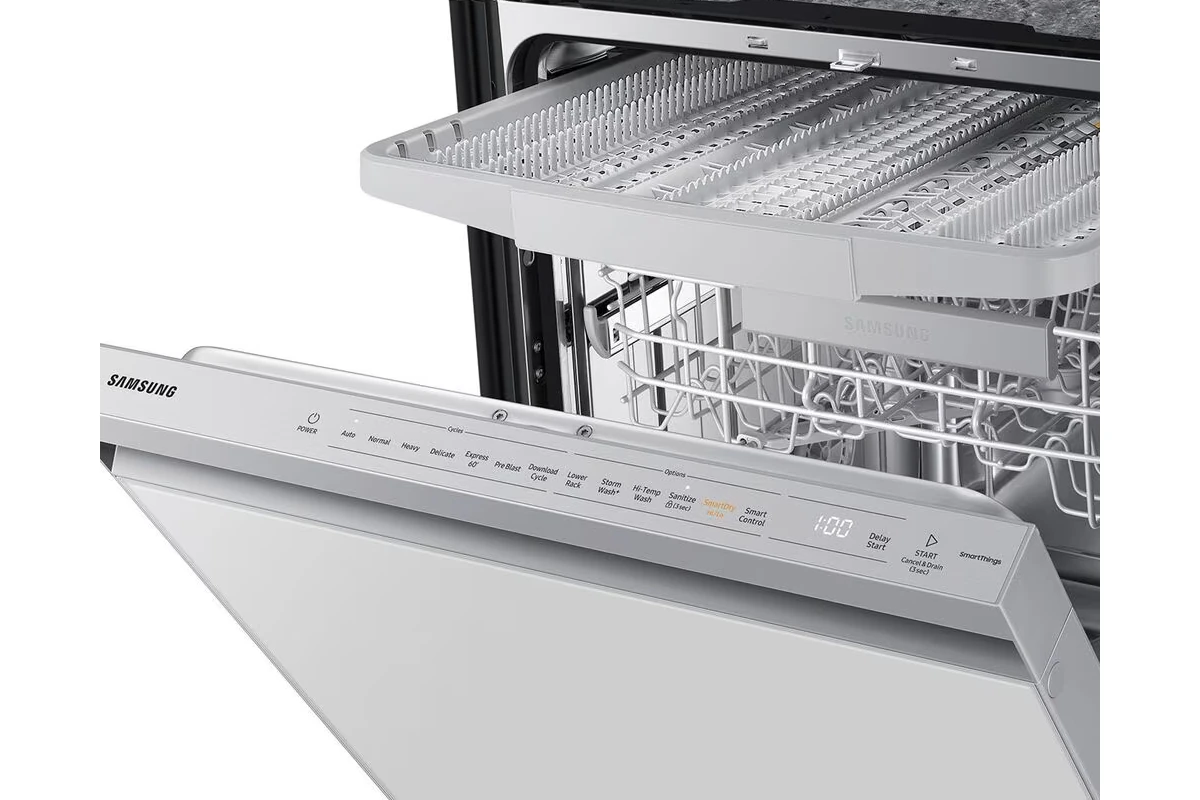If your Samsung dishwasher shows the LC error code, it means there might be a leak. This can be frustrating, but you can try some steps before calling for help. Keeping filters clean, using the right detergent, checking the door seal, making sure the dishwasher is level, and loading dishes properly can help prevent this error. Taking care of your dishwasher with these simple steps can make it last longer and work better. Understanding and fixing the LC error code can save time and prevent damage. This guide will help you troubleshoot and fix the issue.
Troubleshooting Your Samsung Dishwasher LC Code
Understanding the LC Code
The LC error code on your Samsung dishwasher indicates a leak or excess moisture. It’s a safety feature designed to prevent water damage. However, it can also be triggered by a few other factors, which we’ll address.
Common Causes and Fixes
| Cause | Solution |
|---|---|
| Leaky Hose or Connections | Inspect all hoses and connections for leaks or damage. Tighten or replace as needed. |
| Clogged or Damaged Spray Arm | Check for cracks, clogs, or obstructions in the spray arms. Clean or replace if necessary. |
| Overfilled Detergent Dispenser | Use the recommended amount of detergent and avoid overfilling the dispenser. |
| Faulty Water Inlet Valve | If the valve is not closing properly, it can cause a leak. Replace the valve if it’s faulty. |
| Leaky Pump Seal | If the pump seal is worn out, it can leak. Replacing the seal should fix the problem. |
| Moisture on the Leak Sensor (False Alarm) | Wipe the sensor dry with a clean cloth and reset the dishwasher. |
| Door Seal Not Sealing Properly | Clean the door seal and ensure it’s properly aligned. Replace it if it’s damaged. |
Additional Tips
- Reset the Dishwasher: Turn off the dishwasher, unplug it for a few minutes, and then plug it back in. This can sometimes reset the error code.
- Check the Float Switch: The float switch prevents the dishwasher from overfilling. If it’s stuck, it might trigger the LC code. Gently press it down to see if it moves freely.
- Contact Samsung Support: If you’ve tried all the troubleshooting steps and the LC code persists, contact Samsung customer support for further assistance. They may be able to diagnose the problem remotely or send a technician to repair your dishwasher.
Important Note: Always turn off the power to your dishwasher before attempting any repairs or troubleshooting. If you’re not comfortable working with appliances, it’s best to call a professional.
Key Takeaways
- Understand the LC Code: The LC code on a Samsung dishwasher signifies a leak sensor alarm, indicating water in the base pan, a situation that requires immediate attention to prevent potential water damage.
- Common Causes: Contributing factors to an LC code alarm include over-sudsing due to excessive detergent use, leaking hoses, faulty components, or even high humidity levels. Regular maintenance and using the correct type and amount of detergent can prevent these issues.
- Troubleshooting Steps: To resolve the LC code, power down the dishwasher, inspect for leaks, ensure the appliance is level, and check the water inlet valve. Performing regular maintenance like cleaning filters and checking for blockages is also crucial.
- Professional Intervention: If troubleshooting doesn’t clear the LC code, or if it reappears, this suggests a persistent leak that might require professional repair to prevent further damage or inconvenience.
- Preventive Measures: Regularly clean the dishwasher’s filter and drain area, use the correct detergent in the recommended amount, check the door seal for wear, ensure the dishwasher is level, and avoid overloading the appliance to reduce the risk of triggering the LC code.
What is the Samsung Dishwasher LC Code?
When a Samsung dishwasher displays an LC code, it’s signaling a specific issue: water has been detected in the base pan underneath the dishwasher. This code is Samsung’s way of alerting users that the appliance’s leak sensor has been triggered. Understanding what this code means can help homeowners address the problem before it leads to more serious water damage in their kitchen.
The LC code, sometimes mistaken for 1E, functions as a protective measure. It’s designed to prevent further operation of the dishwasher, which could exacerbate the leakage and potentially cause damage to floors or cabinets. When this code flashes, it’s advising that the dishwasher needs immediate attention.
Several factors might cause the appearance of an LC code on a Samsung dishwasher. These can range from a simple over-sudsing due to excessive detergent use, to a leaking hose or a faulty component. Sometimes, even high humidity levels in the kitchen can trigger this alarm. Identifying the root cause is the first step in resolving the issue.
To troubleshoot the LC code, users should first power off the dishwasher and inspect for obvious signs of leaks. Checking hoses, connections, and seals for wear or damage can help pinpoint the problem. If the issue isn’t immediately apparent, drying out the base pan and resetting the dishwasher may clear the code. However, if the code reappears, it suggests a persistent leak that might require professional attention.
Addressing an LC code promptly can help avoid the inconvenience of a non-operational dishwasher and more significantly, prevent costly water damage to your home. Regular maintenance and being mindful of detergent amounts can also minimize the risk of triggering this leak sensor alarm.
Causes of the LC Code
When a Samsung dishwasher displays the LC code, it’s signaling a specific issue: water has been detected in the wrong place. But what leads to this situation? Several factors can trigger the alarm, each originating from different parts of the dishwasher’s system.
First off, over-sudsing is a common culprit. Too much detergent or the wrong type can create excess suds. These suds can spill over into areas they shouldn’t, like the base pan. It’s key to use the correct detergent and amount recommended by Samsung.
Leaky hoses or seals also lead to trouble. Over time, wear and tear can cause small gaps in the dishwasher’s water pathways. These leaks, though often minor, can accumulate water in the base pan, activating the LC code.
Loose or damaged components present another issue. Components like the water inlet valve, if not secured properly, can drip water into the base pan. Regular checks can help catch these problems early.
Lastly, the dishwasher could be improperly positioned, leading to unintended water flow into the base pan. Ensuring the dishwasher is level can prevent such mishaps.
Addressing the LC code promptly avoids lengthy disruptions and potential water damage. Regular maintenance and attention to detergent usage are effective preventative measures.
How to Troubleshoot the LC Code
Troubleshooting the Samsung dishwasher LC code involves several practical steps. This error signals water where it shouldn’t be, and addressing it quickly helps avoid more severe issues.
First off, Power Down the dishwasher. Unplugging the machine or turning off the circuit breaker for a minute can reset the system. Sometimes, a quick reset is all it takes to clear the code.
Next, Check for Over-Sudsing. If you’ve used too much or the wrong type of detergent, it can create excessive suds and trigger the LC code. Run a rinse cycle without dishes to see if this resolves the issue.
Inspect Hoses and Seals for signs of wear or damage. Leaks from hoses or not properly sealed doors can lead to water gathering underneath the appliance, setting off the alarm. Replace any worn-out parts to stop water from escaping.
Another vital step is to Ensure the Dishwasher is Level. An uneven dishwasher can cause water to collect and signal the LC code. Use a level to check and adjust the legs of the dishwasher as needed.
Examine the Water Inlet Valve. It’s responsible for letting water into your dishwasher. If it’s loose or damaged, it can leak water. Tightening or replacing the valve can often solve the problem.
Finally, don’t forget to Perform Regular Maintenance. Clean the dishwasher’s filters and check for any debris blocking the drainage system. A properly maintained dishwasher is less likely to encounter issues like the LC code.
By following these steps, you can effectively address the LC code on your Samsung dishwasher. Regular checks and quick action when problems arise keep your dishwasher running smoothly.
Steps to Fix the LC Code Issue
When a Samsung dishwasher displays the LC code, it signals a leak. This means the machine has detected water where it shouldn’t be. Fixing this issue promptly can prevent bigger problems. Here’s what users can do.
First, power down the dishwasher. Unplug it or turn off the circuit breaker. Wait for 15 minutes before powering it back on. This step might reset the error.
Next, check for too much suds. Sometimes, using too much soap causes extra foam which tricks the dishwasher into sensing a leak. Try running a rinse cycle without dishes to see if this clears up the problem.
Inspect hoses and seals for any signs of damage. Cracks or loose connections can let water escape, triggering the LC code. Replace any damaged parts.
Make sure the dishwasher is level. An uneven dishwasher might cause water to pool and set off the leak sensor. Adjust the legs until it’s perfectly horizontal.
Look at the water inlet valve. If it’s leaking, that could be the problem. This part might need replacing.
Regular maintenance goes a long way. Clean the filters often. Blocked filters can cause water to back up and lead to errors.
By following these steps, Samsung dishwasher users can often solve the LC code issue themselves. If the problem persists, it’s smart to contact a professional. This approach keeps the dishwasher running smoothly and avoids the hassle of unnecessary repair bills.
Additional Tips for Preventing the LC Code
Preventing the LC code error on a Samsung dishwasher starts with understanding what causes it. This code signals water leakage but avoiding it can save time and frustration. Here’s how to keep the dishwasher running smoothly without encountering this interruption.
First, stay proactive about maintenance. Regularly clean the dishwasher’s filter and drain area. These are common spots where food particles and debris collect, potentially leading to blockages. When these blockages occur, water cannot exit properly, increasing the risk of leaks.
Second, use the correct type of detergent and the recommended amount. Overuse of detergent can create excessive suds which might trick the dishwasher into thinking there’s a leak. This is because too many suds can overflow the dishwasher’s containment areas, prompting an LC code alert.
Another tip is to check the dishwasher’s door seal. Over time, door seals can wear out or get damaged, allowing water to escape. If the seal is not snug, water finds its way out, and the LC code appears. Inspect the seal for any signs of wear, tear, or gaps and replace it if necessary.
Ensuring the dishwasher is level also plays a critical role in preventing leaks. An uneven dishwasher can cause water to pool and eventually leak out, triggering the LC code. Use a level to check if the appliance is properly balanced and adjust the feet accordingly.
Lastly, consider the load size and arrangement of dishes. Overloading the dishwasher or placing dishes improperly can block the water spray, causing water to splash and leak. Follow the manufacturer’s guidelines for loading to ensure optimal water flow and prevent blockages.
By adhering to these additional preventive measures, users can significantly reduce the chances of facing the LC code error, prolonging the life of their Samsung dishwasher.
Frequently Asked Questions
What does the Samsung dishwasher LC code mean?
The LC code on a Samsung dishwasher signals a leak in the system. It’s a warning that water has escaped from its designated path, potentially due to a fault or obstruction.
How can I prevent the LC code error on my Samsung dishwasher?
Preventing the LC code error involves regular maintenance such as cleaning the filters, using the correct amount of detergent to avoid blockages, ensuring the dishwasher is level, checking the door seal for integrity, and loading dishes properly to prevent misalignment that could lead to leaks.
Why is it important to use the correct detergent amount in a Samsung dishwasher?
Using the correct amount of detergent is crucial because too much can create excess suds and foam, leading to blockages and leaks. This, in turn, might trigger the LC code error indicating a leak.
How does cleaning the filters help prevent Samsung dishwasher leaks?
Cleaning the filters removes food particles and debris, ensuring water flows freely. This prevents clogs that can cause water to overflow internally and trigger the leak indicator (LC code).
What role does leveling play in preventing dishwasher leaks?
If a dishwasher is not level, water may not drain properly, increasing the risk of leaks. Ensuring your dishwasher is level helps prevent water from pooling and leaking, thus avoiding the LC code error.
Can improperly loaded dishes cause leaks in Samsung dishwashers?
Yes, improperly loaded dishes can block the spray arms or cause the door not to seal properly. This could lead to water escaping the dishwasher, potentially causing leaks and the activation of the LC code.







